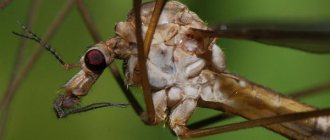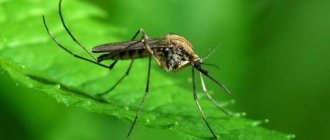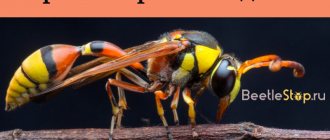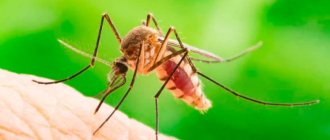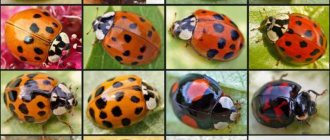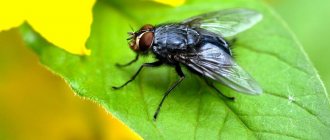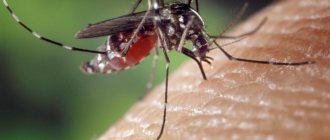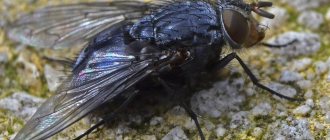Who are mosquitoes?
Mosquitoes are a family of dipterous insects that belong to the long-whiskered group. Mosquitoes have a rather complex classification. The family is divided into 2 subfamilies, one of which, in turn, is divided into tribes, then into genera and species.
Appearance of a mosquito
Interesting fact: Among insects, only females bite, since males have underdeveloped jaws. Female mosquitoes are part of the midges - a group of dipterous blood-sucking insects, which also includes midges, mosquitoes and other families.
What diseases do blood-sucking mosquitoes carry?
Blood-sucking insects spread viruses, bacteria and parasites. Let's look at what diseases mosquitoes carry:
- Malaria. The carrier is a malarial species. When infected with this disease, fever and joint aches are observed. A dangerous disease can even lead to death.
- Tularemia. Up to 250 cases of infection are recorded annually. The disease is characterized by fever, severe headache, weakness and aching joints. The carriers are mosquitoes and biting mosquitoes.
- West Nile fever occurs in humans in the form of an acute febrile disease with symptoms of general intoxication, moderate polyadenitis, with headaches and muscle pain, in severe cases with the development of serous meningitis, meningoencephalitis and acute flaccid paralysis. Human infection occurs through the bite of blood-sucking mosquitoes. West Nile fever is a widespread infectious disease that is endemic in more than 90 countries around the world. The most difficult situation is in the European region and North America.
- Japanese encephalitis. In our country, you can become infected in the Primorsky Territory. The symptoms of a dangerous illness in the form of fever, weakness, headache, manifest themselves sharply. Carried by common mosquitoes.
- Meningitis. When infected, weakness, fever, severe headache, and clouding of consciousness occur. In the absence of adequate therapy, it can lead to serious complications. In 10% of cases it ends in death.
- Filariasis. Mosquitoes can introduce larvae into the human body, from which they grow into nematode roundworms, which disrupt the functioning of the lymphatic system. The disease is accompanied by swelling, enlargement of any part of the body, and inflammation of the skin.
Mosquito: description, structure, characteristics. What does a mosquito look like?
The mosquito has a thin body (4-14 mm), long legs, and narrow, transparent wings (their span is 5-30 mm). Most are yellow, gray or brown. There are also green and black insects.
Body structure of a mosquito
The mosquito's abdomen has an elongated shape. It is divided into 10 segments. The chest part of the body is noticeably wider. At the end of each paw there are pairs of claws. There are scales on the surface of the wings. In places where their density is too high, spots can be seen.
Mosquitoes have a pair of antennae consisting of 15 parts. The oral apparatus of insects is of the piercing-sucking type. Both females and males have a proboscis. However, in females it is longer and equipped with piercing bristles.
Interesting fact : although females are larger than males, their weight barely reaches 1 gram. Getting into the web, the insect does not create vibrations - the spider will not even notice the presence of the mosquito.
The structure of the oral apparatus distinguishes insects from other blood-sucking insects. The organs are represented by the lips – upper and lower. Due to their elongated shape, they form a case, inside of which there are jaws. The jaws are small and sharp, file-shaped.
Mouthparts of various insects
Feeding characteristics of males
The peculiarities of the diet of males make them absolutely harmless insects for humans, since throughout their entire lives they eat only plant foods.
Substances that are necessary for their short-term life are accumulated by the body during the larval stage. Their oral apparatus is characterized by the absence of cutting elements.
Where do mosquitoes live and winter?
Mosquitoes adapt to environmental conditions. For example, tropical species are active all year round, and inhabitants of the temperate zone in winter fall into “hibernation” - diapause, during which all processes in the body slow down.
Arctic mosquitoes lead an active lifestyle only a few weeks a year, breeding intensively. When temperatures briefly become comparatively warmer in these regions, the upper layers of ice melt. At this time, mosquitoes actively feed on local large animals.
Mosquito larvae in water
Mosquito eggs that are accustomed to a temperate climate are able to withstand cold weather - snow and low temperatures. Most often they float on water and do not freeze, despite the temperature.
Adults can wait out the winter in basements, where it is warm and maintains a high level of moisture. In the wild, females hide in animal burrows, inside logs and other natural shelters.
Habitats
Almost everywhere, except always cold
Antarctica, but these insects are most common in areas with a hot and humid climate, where they remain active throughout the year. In temperate latitudes, during the winter cold, they hibernate, awakening with the arrival of spring. It is interesting that even in the Arctic, during those few weeks when it gets warm, mosquitoes breed with terrible force and are very annoying to the herds of deer there.
When do mosquitoes appear and disappear?
Some mosquitoes can hibernate and wake up as the weather gets warmer. In other species, overwintering larvae begin to hatch in the spring. The optimal temperature for them is +10℃ at night. And the hotter it gets, the more insects become active. Peak mosquito activity is in the summer months.
Interesting: Interesting facts about dragonflies, photos and videos
Mosquitoes begin to disappear when the temperature at night drops to +10℃. Wintering species are in search of shelters. When the first sub-zero temperatures arrive, the mosquito season finally ends.
Mosquito on melted ice
Due to the small weight of the insect, the wind creates serious obstacles for it. Thanks to the wind, mosquitoes can travel longer distances faster. But most often it serves as a hindrance. For example, a mosquito cannot stay on a surface (including human skin) if the wind force reaches 10 meters per second.
Interesting fact : if the weather suddenly gets warmer during the cold season, mosquitoes may come out of hibernation, but then disappear again when the weather gets colder.
Since there are many natural areas in Russia, mosquitoes can appear and disappear at different times, depending on the region. For example, in the south they become active in March, and in the north only in June. The same applies to the duration of the active lifestyle of insects.
Beginning of life
First you need to find out where mosquitoes come from. These small, ubiquitous insects emerge from eggs that females carefully lay on the surface of the water. The clutch immediately sinks to the bottom and after a few weeks the eggs turn into pupae, fully adapted to existence in an aquatic environment.
After some time, the small pupa completes the formation of all organs, after which it floats to the surface of the reservoir, the cocoon opens and an adult emerges from it.
What do mosquitoes eat? Why do they bite?
The basis of insect nutrition is plants - juices, nectar. Females that suck blood are ectoparasites. Some species must obtain sufficient amounts of valuable substances from the blood in order to lay eggs. For other females, sucking blood simply increases the number of eggs.
Mosquito feeds on plant nectar
Thus, insects have two food sources: blood and plant material. Both types serve as carbohydrates - energy. The blood contains much more other useful substances: fats (lipids), proteins. Protein is the main material in the production of eggs.
Interesting fact : the nature and feeding habits of mosquitoes allow us to judge the distribution of responsibilities between females and males. Females are aimed at reproducing offspring, and males do not need blood as a source of protein.
For ectoparasites, the hosts are most often warm-blooded vertebrates such as mammals and birds. However, some types of mosquitoes are capable of feeding on the blood of fish and reptiles.
Diet of the mosquito family
Few people know that mosquitoes feed on flower nectar, juices, and pollen in addition to blood. Immediately after birth, the young generation gathers in the grass near a lake, pond, or swamp. For some time they lead a carefree life, content with a small amount of food. Then they gather in flocks and the mating season begins. It lasts about a week.
On a note!
The diet of a fertilized female changes significantly, she becomes aggressive and thirsts for blood. Male mosquitoes continue to feed on plant foods, live in the wild, and do not harm either humans or animals.
Most representatives of the mosquito family are found in the forest, in a swamp, near a pond, and also near a large puddle. For the development of larvae, standing water or damp soil is needed. Having drunk blood, the female digests it for several days, and during this time eggs are formed inside. After a few days, the mosquito lays them in a pond with stagnant water.
How does a mosquito bite?
Before biting the victim, the mosquito must find it. His sense of smell is responsible for this process. There are 72 types of receptors located on the insect antennae. At least about 30 of them are able to recognize various substances that are present in the sweat of humans and animals.
Mosquitoes are able to distinguish the movement of an object in space. When the insect approaches, we hear an annoying buzzing sound. This sound occurs due to very fast and frequent flapping of the wings. Mosquitoes bite more actively at night.
The female mosquito plunges her proboscis into the hole she made.
Having discovered the victim, the female sits on the surface of the skin, clinging to it with her claws. She then easily pierces the skin using her sharp jaws. The proboscis plunges into the hole. But before sucking in the blood, the mosquito injects its saliva.
It contains special substances - coagulants, which slow down blood clotting. The female immerses her proboscis quite deeply - up to the blood capillaries. Through it, it absorbs blood, from which it receives valuable substances.
The process of absorption of food by a mosquito takes no more than a minute. After this short time, the previously barely noticeable body of the insect becomes larger. The walls of the abdomen stretch and you can even see blood through them.
Photo of a mosquito under magnification
Interesting fact : mosquitoes rarely travel long distances. During their entire life cycle, they are usually found within an area of one kilometer.
Features of the insect
Mosquitoes are a large family of insects, which includes about 3.5 thousand species. They live all over the world, with the exception of Antarctica, that is, wherever people live whose blood is needed to reproduce.
Successful life of bloodsuckers is possible with a comfortable level of moisture and heat, which is why most of the genus are inhabitants of the tropics. If we talk about the temperate zone of climatic conditions, they prefer places near reservoirs, river valleys, shady forests and swamps. Photos of the appearance can be seen below.
If you are interested in the answer to the question of what mosquitoes eat near swamps and forests, then they consume liquid containing sugar - they get it from the sap of vegetation. But to be able to lay eggs, from which larvae and pupae emerge, female members of the family require the blood of a warm-blooded animal, in some cases, reptiles. Of course, they prefer human lymph.
How many times can the same mosquito bite?
Mosquitoes have no limit on the number of times they can bite. As a rule, the female tries to be completely satisfied with blood in one bite. If something bothers her, she flies away for a short time, and then returns to her victim again. When fully saturated, the female needs some time to digest the blood and also lay eggs while her body has enough “building” materials.
Mosquito under a microscope
Then she will start searching for food again. For example, thanks to observation of mosquitoes, it was possible to find out that the insect is capable of biting at least 15 times per day. A female mosquito may go through a couple of cycles in which feeding alternates with laying eggs.
Interesting: Spiders
